Dye Dale, O`neill Robert. The road to victory: From Pearl Harbor to Okinawa
Подождите немного. Документ загружается.

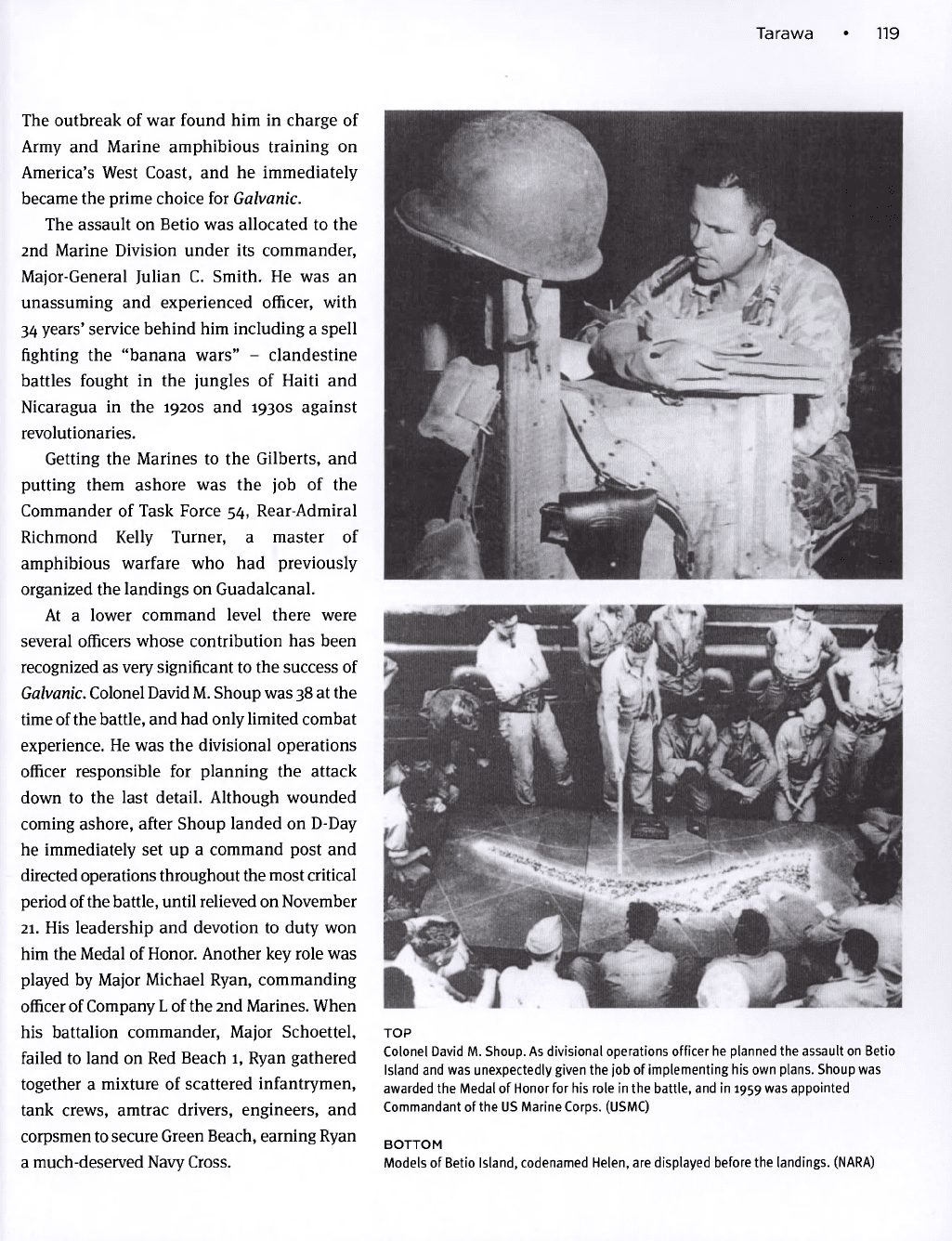
Tarawa • 119
The outbreak of war found him in charge of
Army and Marine amphibious training on
America's West Coast, and he immediately
became the prime choice for Galvanic.
The assault on Betio was allocated to the
2nd Marine Division under its commander,
Major-General Julian C. Smith. He was an
unassuming and experienced officer, with
34 years' service behind him including a spell
fighting the "banana wars" - clandestine
battles fought in the jungles of Haiti and
Nicaragua in the 1920s and 1930s against
revolutionaries.
Getting the Marines to the Gilberts, and
putting them ashore was the job of the
Commander of Task Force 54, Rear-Admiral
Richmond Kelly Turner, a master of
amphibious warfare who had previously
organized the landings on Guadalcanal.
At a lower command level there were
several officers whose contribution has been
recognized as very significant to the success of
Galvanic. Colonel David M. Shoup was 38 at the
time of the battle, and had only limited combat
experience. He was the divisional operations
officer responsible for planning the attack
down to the last detail. Although wounded
coming ashore, after Shoup landed on D-Day
he immediately set up a command post and
directed operations throughout the most critical
period of the battle, until relieved on November
21. His leadership and devotion to duty won
him the Medal of Honor. Another key role was
played by Major Michael Ryan, commanding
officer of Company L of the 2nd Marines. When
his battalion commander, Major Schoettel,
failed to land on Red Beach 1, Ryan gathered
together a mixture of scattered infantrymen,
tank crews, amtrac drivers, engineers, and
corpsmen to secure Green Beach, earning Ryan
a much-deserved Navy Cross.
TOP
Colonel David M. Shoup. As divisional operations officer he planned the assault on Betio
Island and was unexpectedly given the job of implementing his own plans. Shoup was
awarded the Medal of Honor for his role in the battle, and in 1959 was appointed
Commandant of the US Marine Corps. (USMC)
BOTTOM
Models of Betio Island, codenamed Helen, are displayed before the landings. (NARA)
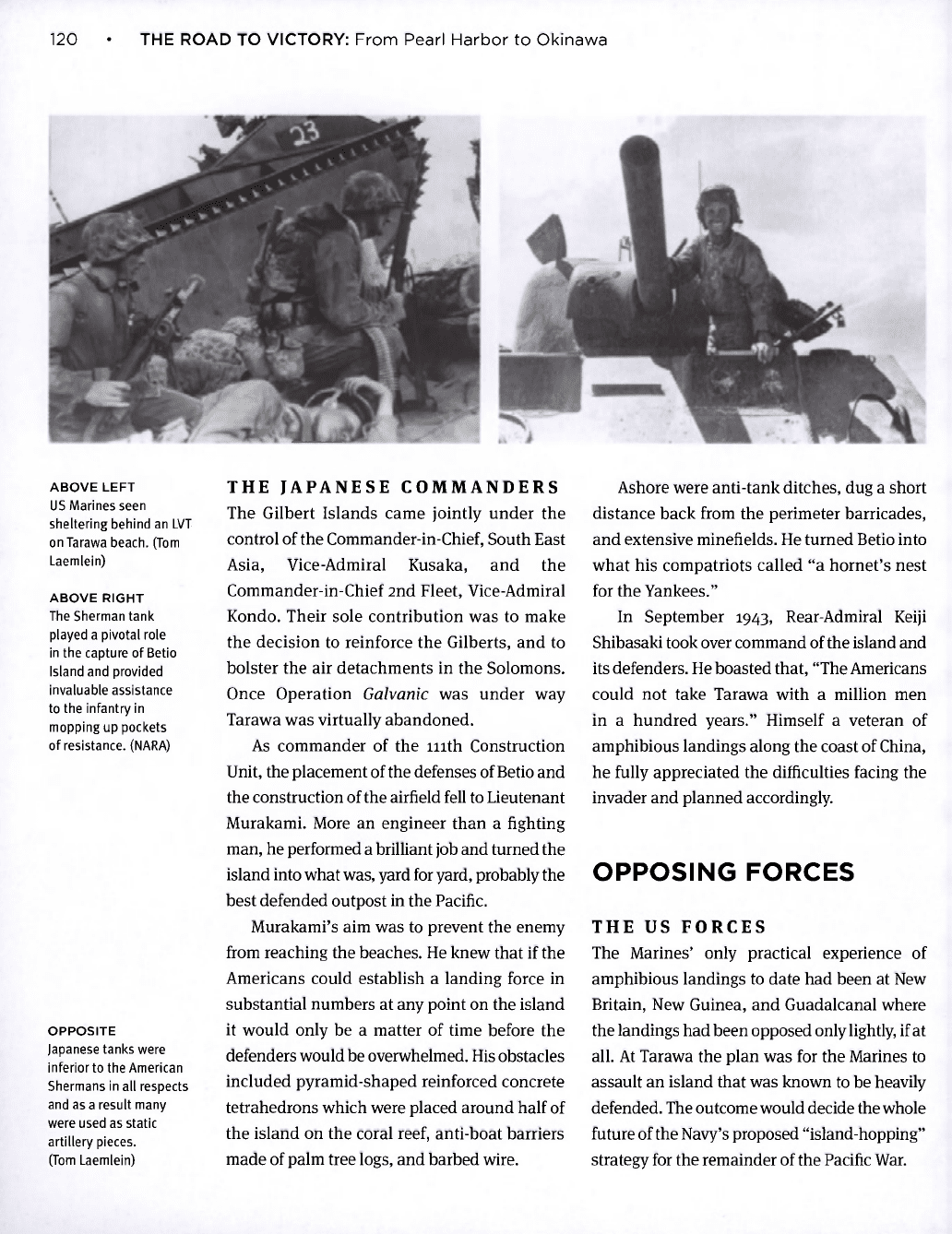
120 • THE ROAD TO VICTORY: From Pearl Harbor to Okinawa
THE JAPANESE COMMANDERS
The Gilbert Islands came jointly under the
control of the Commander-in-Chief, South East
Asia, Vice-Admiral Kusaka, and the
Commander-in-Chief 2nd Fleet, Vice-Admiral
Kondo. Their sole contribution was to make
the decision to reinforce the Gilberts, and to
bolster the air detachments in the Solomons.
Once Operation Galvanic was under way
Tarawa was virtually abandoned.
As commander of the 111th Construction
Unit, the placement of the defenses of Betio and
the construction of the airfield fell to Lieutenant
Murakami. More an engineer than a fighting
man, he performed a brilliant job and turned the
island into what was, yard
for
yard, probably the
best defended outpost in the Pacific.
Murakami's aim was to prevent the enemy
from reaching the beaches. He knew that if the
Americans could establish a landing force in
substantial numbers at any point on the island
it would only be a matter of time before the
defenders would be overwhelmed. His obstacles
included pyramid-shaped reinforced concrete
tetrahedrons which were placed around half of
the island on the coral reef, anti-boat barriers
made of palm tree logs, and barbed wire.
OPPOSITE
Japanese tanks were
inferior to the American
Shermans in all respects
and as a result many
were used as static
artillery pieces.
(Tom Laemlein)
Ashore were anti-tank ditches, dug a short
distance back from the perimeter barricades,
and extensive minefields. He turned Betio into
what his compatriots called "a hornet's nest
for the Yankees."
In September 1943, Rear-Admiral Keiji
Shibasaki took over command of the island and
its defenders. He boasted that, "The Americans
could not take Tarawa with a million men
in a hundred years." Himself a veteran of
amphibious landings along the coast of China,
he fully appreciated the difficulties facing the
invader and planned accordingly.
OPPOSING FORCES
THE US FORCES
The Marines' only practical experience of
amphibious landings to date had been at New
Britain, New Guinea, and Guadalcanal where
the landings had been opposed only lightly, if at
all. At Tarawa the plan was for the Marines to
assault an island that was known to be heavily
defended. The outcome would decide the whole
future of the Navy's proposed "island-hopping"
strategy for the remainder of the Pacific War.
ABOVE LEFT
US Marines seen
sheltering behind an LVT
on Tarawa beach. (Tom
Laemlein)
ABOVE RIGHT
The Sherman tank
played a pivotal role
in the capture of Betio
Island and provided
invaluable assistance
to the infantry in
mopping up pockets
of resistance. (NARA)
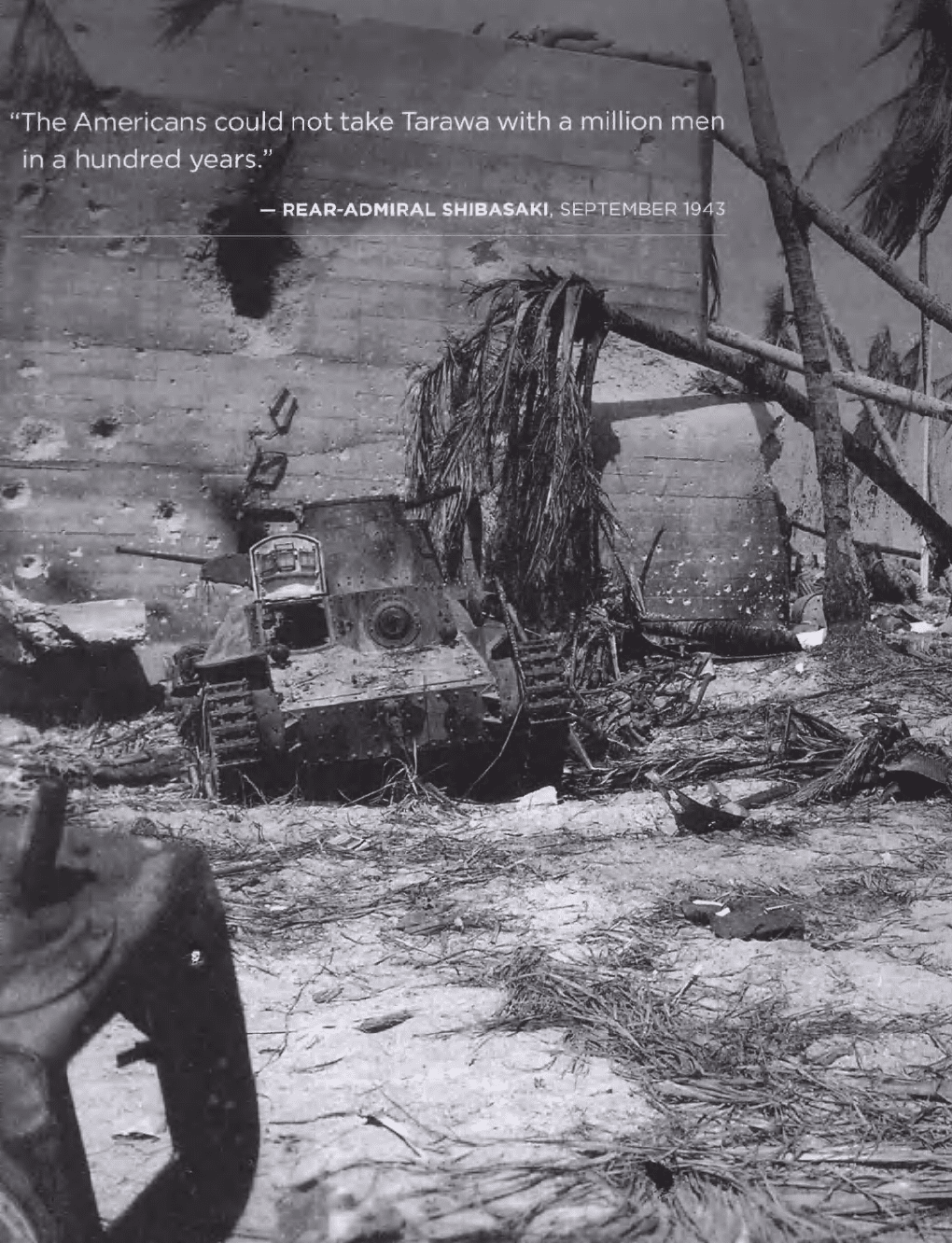
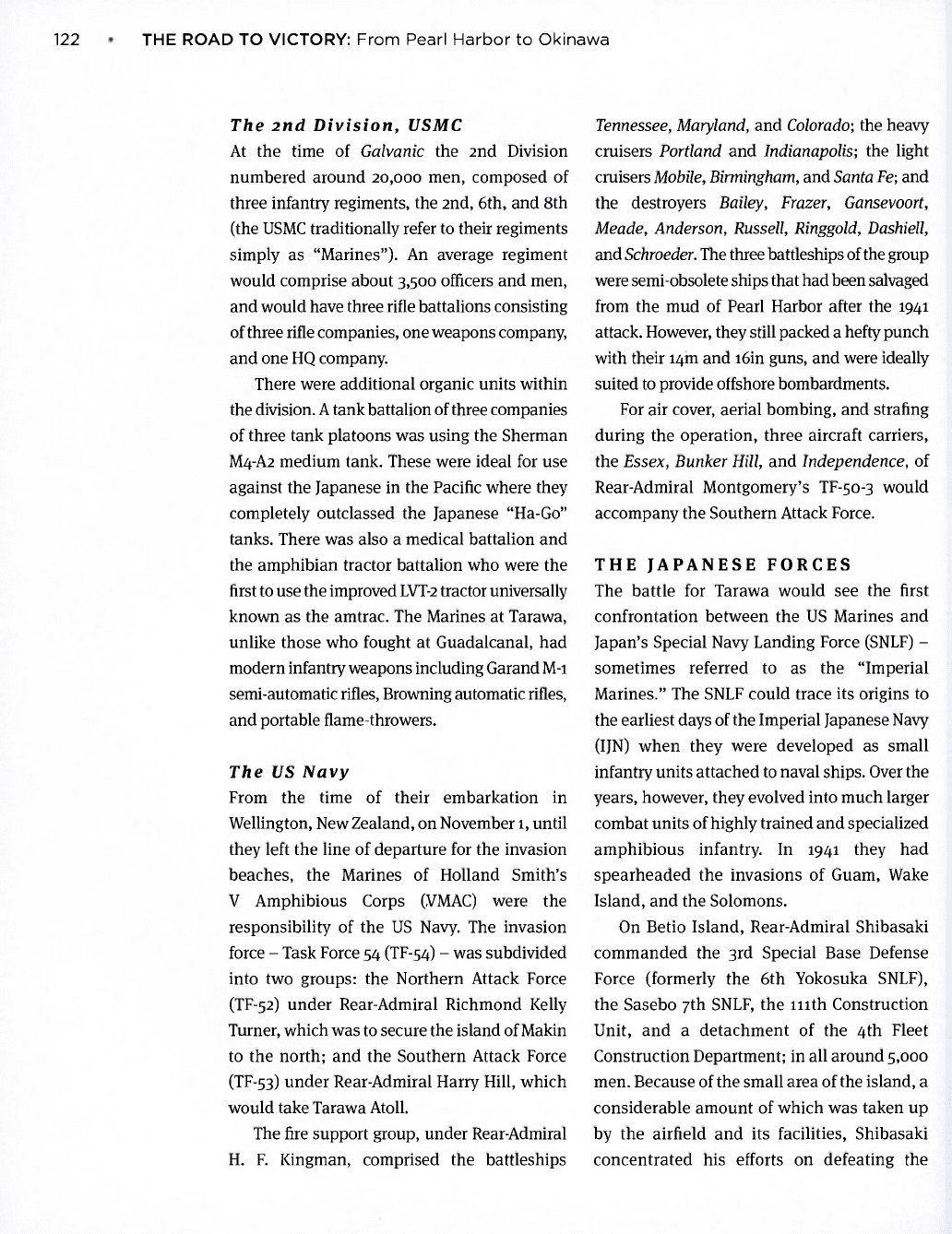
122 • THE ROAD TO VICTORY: From Pearl Harbor to Okinawa
The 2nd Division, USMC
At the time of Galvanic the 2nd Division
numbered around 20,000 men, composed of
three infantry regiments, the 2nd, 6th, and 8th
(the USMC traditionally refer to their regiments
simply as "Marines")- An average regiment
would comprise about 3,500 officers and men,
and would have three rifle battalions consisting
of three rifle companies, one weapons company,
and one HQ company.
There were additional organic units within
the division. A tank battalion of three companies
of three tank platoons was using the Sherman
M4-A2 medium tank. These were ideal for use
against the Japanese in the Pacific where they
completely outclassed the Japanese "Ha-Go"
tanks. There was also a medical battalion and
the amphibian tractor battalion who were the
first to use the improved LVT-2 tractor universally
known as the amtrac. The Marines at Tarawa,
unlike those who fought at Guadalcanal, had
modern infantry weapons including Garand M-i
semi-automatic rifles, Browning automatic rifles,
and portable flame-throwers.
The US Navy
From the time of their embarkation in
Wellington, New Zealand, on November 1, until
they left the line of departure for the invasion
beaches, the Marines of Holland Smith's
V Amphibious Corps (VMAC) were the
responsibility of the US Navy. The invasion
force - Task Force 54 (TF-54) - was subdivided
into two groups: the Northern Attack Force
(TF-52) under Rear-Admiral Richmond Kelly
Turner, which was to secure the island of Makin
to the north; and the Southern Attack Force
(TF-53) under Rear-Admiral Harry Hill, which
would take Tarawa Atoll.
The fire support group, under Rear-Admiral
H. F. Kingman, comprised the battleships
Tennessee, Maryland, and Colorado; the heavy
cruisers Portland and Indianapolis; the light
cruisers Mobile, Birmingham, and Santa Fe\ and
the destroyers Bailey, Frazer, Gansevoort,
Meade, Anderson, Russell, Ringgold, Dashiell,
and Schroeder. The three battleships of the group
were semi-obsolete ships that had been salvaged
from the mud of Pearl Harbor after the 1941
attack. However, they still packed a hefty punch
with their 14m and i6in guns, and were ideally
suited to provide offshore bombardments.
For air cover, aerial bombing, and strafing
during the operation, three aircraft carriers,
the Essex, Bunker Hill, and Independence, of
Rear-Admiral Montgomery's TF-50-3 would
accompany the Southern Attack Force.
THE JAPANESE FORCES
The battle for Tarawa would see the first
confrontation between the US Marines and
Japan's Special Navy Landing Force (SNLF) -
sometimes referred to as the "Imperial
Marines." The SNLF could trace its origins to
the earliest days of the Imperial Japanese Navy
(IJN) when they were developed as small
infantry units attached to naval ships. Over the
years, however, they evolved into much larger
combat units of highly trained and specialized
amphibious infantry. In 1941 they had
spearheaded the invasions of Guam, Wake
Island, and the Solomons.
On Betio Island, Rear-Admiral Shibasaki
commanded the 3rd Special Base Defense
Force (formerly the 6th Yokosuka SNLF),
the Sasebo 7th SNLF, the 111th Construction
Unit, and a detachment of the 4th Fleet
Construction Department; in all around 5,000
men. Because of the small area of the island, a
considerable amount of which was taken up
by the airfield and its facilities, Shibasaki
concentrated his efforts on defeating the
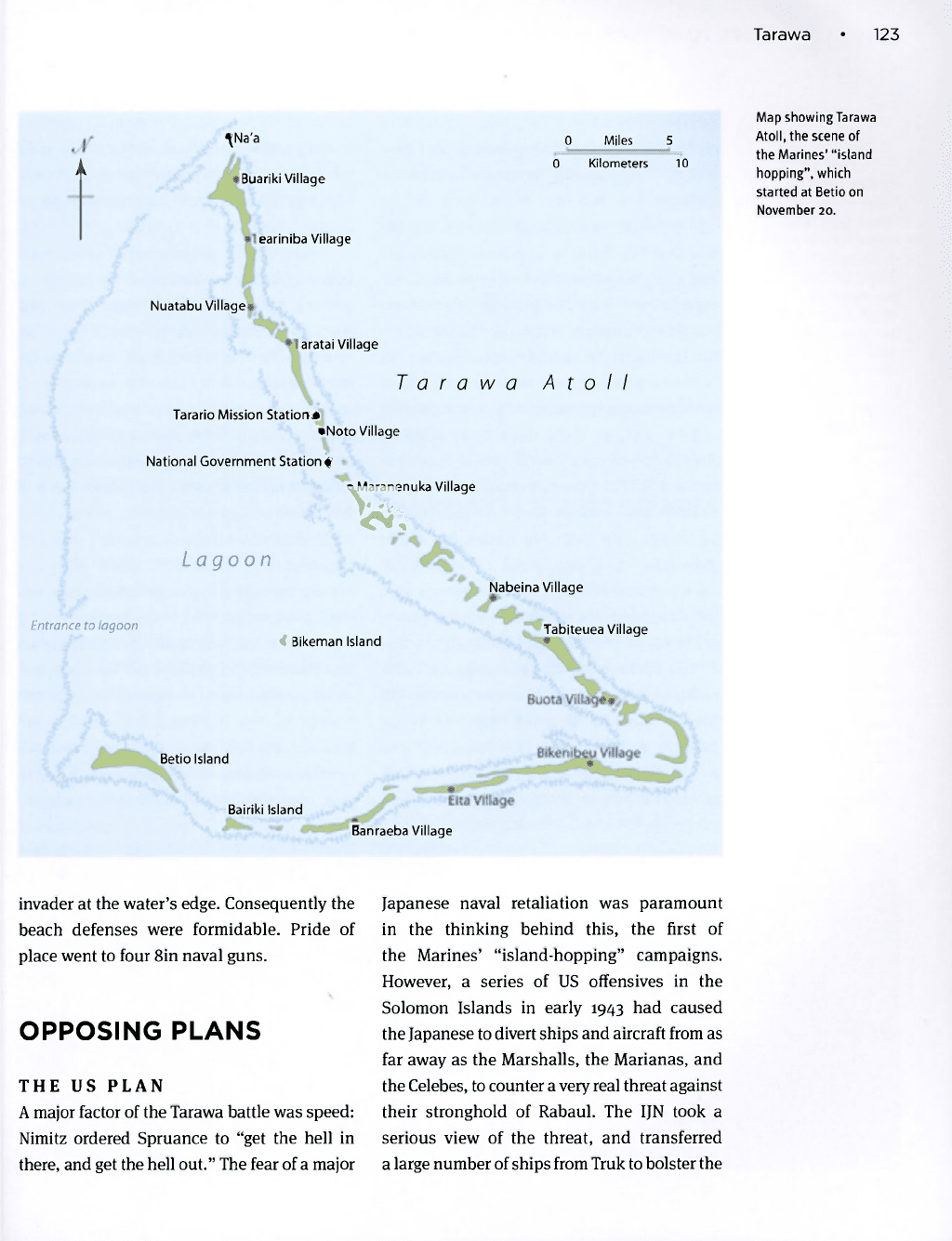
Tarawa • 123
A
Nuatabu Village
^Na'a
Buariki Village
eariniba Village
aratai Village
0 Miles 5
0 Kilometers 10
Tarawa Atoll
Tarario Mission Station*
• Noto Village
National Government Station if
• Maranenuka Village
it Vv
Lagoon
Entrance
to lagoon
4 Bikeman Island
Nabeina Village
Tabiteuea Village
Betio Island
Bairiki Island
Map showing Tarawa
Atoll, the scene of
the Marines' "island
hopping", which
started at Betio on
November 20.
Banraeba Village
invader at the water's edge. Consequently the
beach defenses were formidable. Pride of
place went to four 8in naval guns.
OPPOSING PLANS
THE US PLAN
A major factor of the Tarawa battle was speed:
Nimitz ordered Spruance to "get the hell in
there, and get the hell out." The fear of a major
Japanese naval retaliation was paramount
in the thinking behind this, the first of
the Marines' "island-hopping" campaigns.
However, a series of US offensives in the
Solomon Islands in early 1943 had caused
the Japanese to divert ships and aircraft from as
far away as the Marshalls, the Marianas, and
the Celebes, to counter a very real threat against
their stronghold of Rabaul. The IJN took a
serious view of the threat, and transferred
a large number of ships from Truk to bolster the
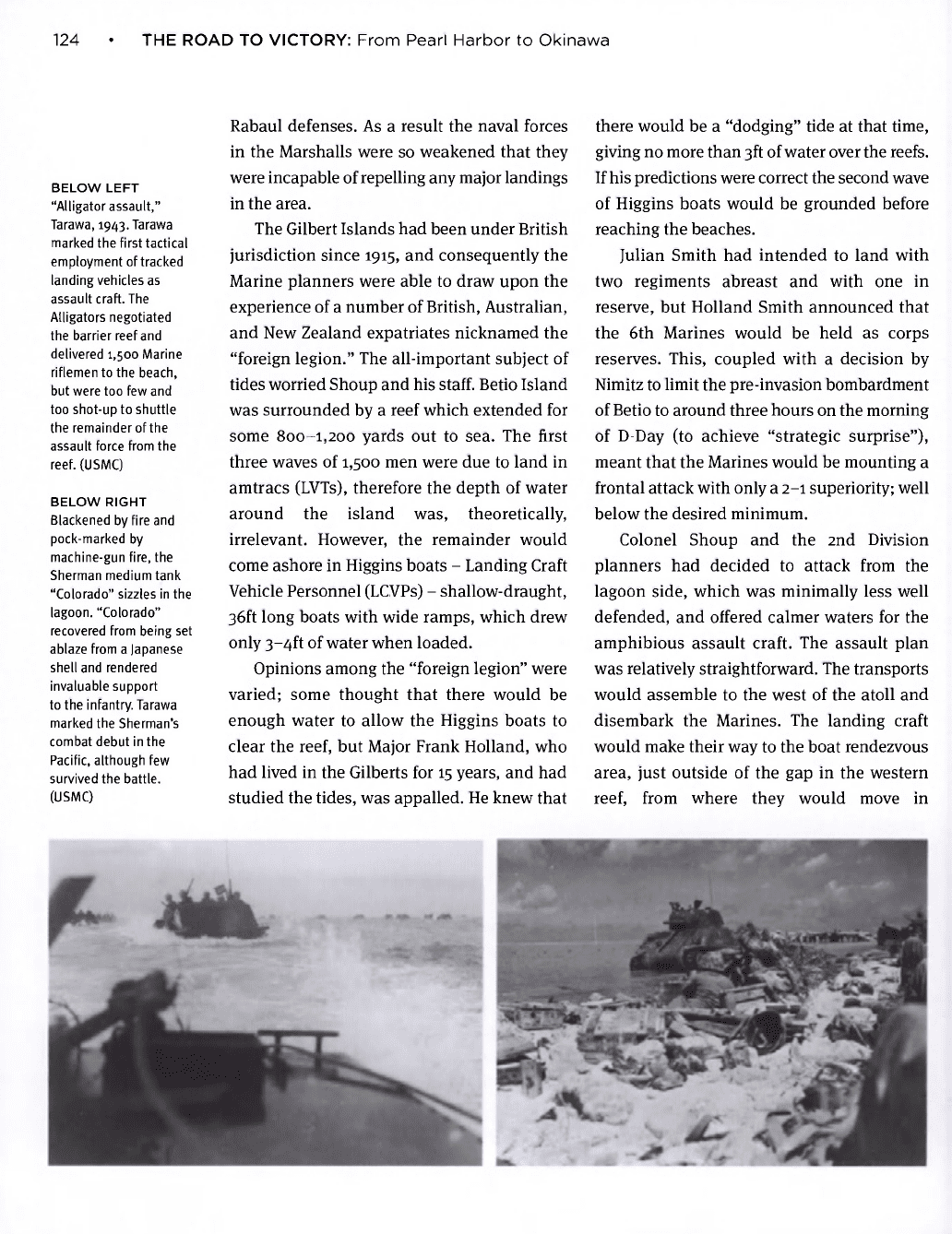
124 • THE ROAD TO VICTORY: From Pearl Harbor to Okinawa
BELOW LEFT
"Alligator assault,"
Tarawa, 1943. Tarawa
marked the first tactical
employment of tracked
landing vehicles as
assault craft. The
Alligators negotiated
the barrier reef and
delivered 1,500 Marine
riflemen to the beach,
but were too few and
too shot-up to shuttle
the remainder of the
assault force from the
reef. (USMC)
BELOW RIGHT
Blackened by fire and
pock-marked by
machine-gun fire, the
Sherman medium tank
"Colorado" sizzles in the
lagoon. "Colorado"
recovered from being set
ablaze from a Japanese
shell and rendered
invaluable support
to the infantry. Tarawa
marked the Sherman's
combat debut in the
Pacific, although few
survived the battle.
(USMC)
Rabaul defenses. As a result the naval forces
in the Marshalls were so weakened that they
were incapable of repelling any major landings
in the area.
The Gilbert Islands had been under British
jurisdiction since 1915, and consequently the
Marine planners were able to draw upon the
experience of a number of British, Australian,
and New Zealand expatriates nicknamed the
"foreign legion." The all-important subject of
tides worried Shoup and his staff. Betio Island
was surrounded by a reef which extended for
some 800-1,200 yards out to sea. The first
three waves of 1,500 men were due to land in
amtracs (LVTs), therefore the depth of water
around the island was, theoretically,
irrelevant. However, the remainder would
come ashore in Higgins boats - Landing Craft
Vehicle Personnel (LCVPs) - shallow-draught,
36ft long boats with wide ramps, which drew
only
3—4ft
of water when loaded.
Opinions among the "foreign legion" were
varied; some thought that there would be
enough water to allow the Higgins boats to
clear the reef, but Major Frank Holland, who
had lived in the Gilberts for 15 years, and had
studied the tides, was appalled. He knew that
there would be a "dodging" tide at that time,
giving no more than 3ft of water over the reefs.
If his predictions were correct the second wave
of Higgins boats would be grounded before
reaching the beaches.
Julian Smith had intended to land with
two regiments abreast and with one in
reserve, but Holland Smith announced that
the 6th Marines would be held as corps
reserves. This, coupled with a decision by
Nimitz to limit the pre-invasion bombardment
of Betio to around three hours on the morning
of D-Day (to achieve "strategic surprise"),
meant that the Marines would be mounting a
frontal attack with only a 2-1 superiority; well
below the desired minimum.
Colonel Shoup and the 2nd Division
planners had decided to attack from the
lagoon side, which was minimally less well
defended, and offered calmer waters for the
amphibious assault craft. The assault plan
was relatively straightforward. The transports
would assemble to the west of the atoll and
disembark the Marines. The landing craft
would make their way to the boat rendezvous
area, just outside of the gap in the western
reef, from where they would move in
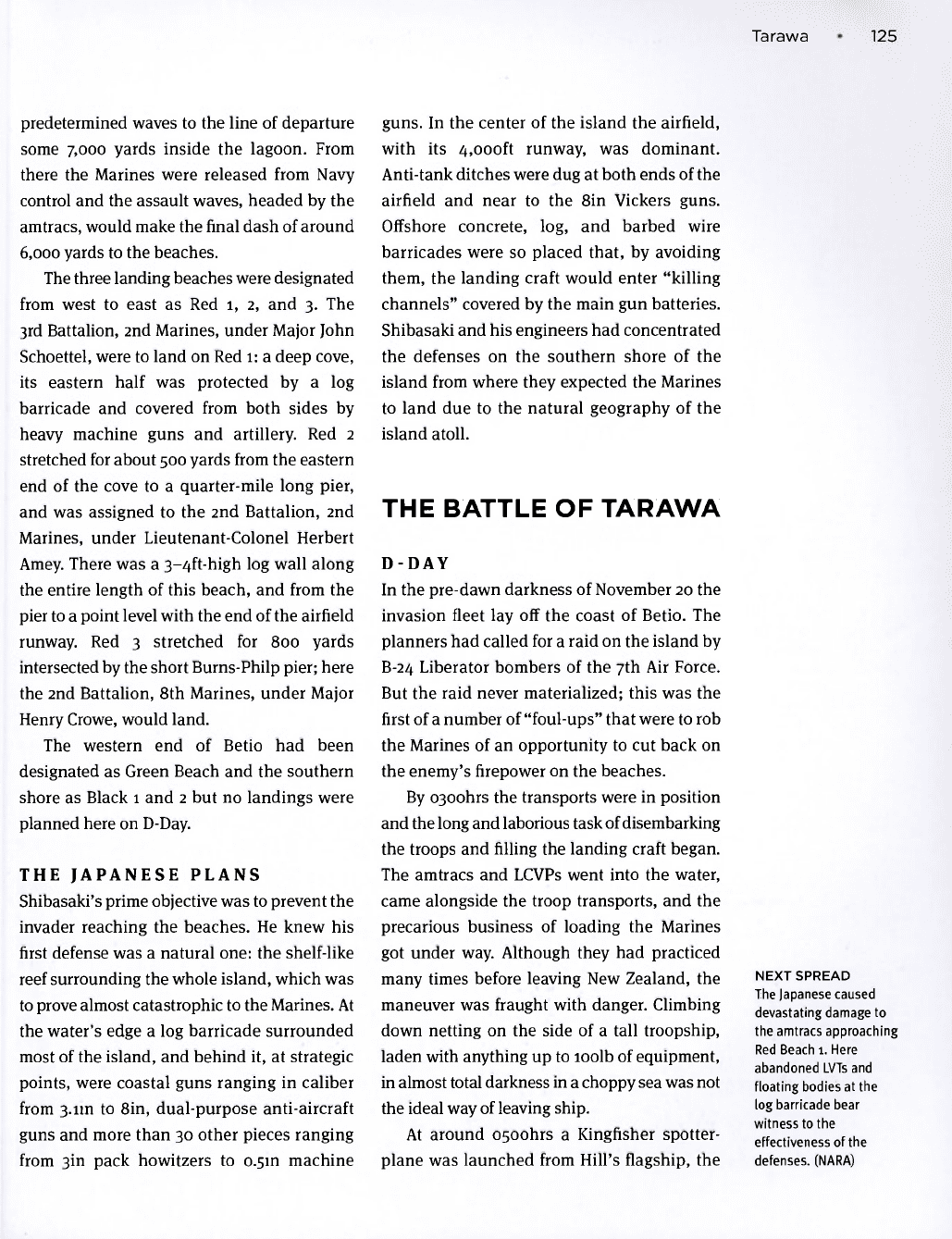
Tarawa •
125
predetermined waves to the line of departure
some 7,000 yards inside the lagoon. From
there the Marines were released from Navy
control and the assault waves, headed by the
amtracs, would make the final dash of around
6,000 yards to the beaches.
The three landing beaches were designated
from west to east as Red l, 2, and 3. The
3rd Battalion, 2nd Marines, under Major John
Schoettel, were to land on Red 1: a deep cove,
its eastern half was protected by a log
barricade and covered from both sides by
heavy machine guns and artillery. Red 2
stretched for about 500 yards from the eastern
end of the cove to a quarter-mile long pier,
and was assigned to the 2nd Battalion, 2nd
Marines, under Lieutenant-Colonel Herbert
Amey. There was a 3-4ft-high log wall along
the entire length of this beach, and from the
pier to a point level with the end of the airfield
runway. Red 3 stretched for 800 yards
intersected by the short Burns-Philp pier; here
the 2nd Battalion, 8th Marines, under Major
Henry Crowe, would land.
The western end of Betio had been
designated as Green Beach and the southern
shore as Black 1 and 2 but no landings were
planned here on D-Day.
THE JAPANESE PLANS
Shibasaki's prime objective was to prevent the
invader reaching the beaches. He knew his
first defense was a natural one: the shelf-like
reef surrounding the whole island, which was
to prove almost catastrophic to the Marines. At
the water's edge a log barricade surrounded
most of the island, and behind it, at strategic
points, were coastal guns ranging in caliber
from 3.1m to 8in, dual-purpose anti-aircraft
guns and more than 30 other pieces ranging
from 3in pack howitzers to 0.5m machine
guns. In the center of the island the airfield,
with its 4,000ft runway, was dominant.
Anti-tank ditches were dug at both ends of the
airfield and near to the 8in Vickers guns.
Offshore concrete, log, and barbed wire
barricades were so placed that, by avoiding
them, the landing craft would enter "killing
channels" covered by the main gun batteries.
Shibasaki and his engineers had concentrated
the defenses on the southern shore of the
island from where they expected the Marines
to land due to the natural geography of the
island atoll.
THE BATTLE OF TARAWA
D-DAY
In the pre dawn darkness of November 20 the
invasion fleet lay off the coast of Betio. The
planners had called for a raid on the island by
B-24 Liberator bombers of the 7th Air Force.
But the raid never materialized; this was the
first of a number of "foul-ups" that were to rob
the Marines of an opportunity to cut back on
the enemy's firepower on the beaches.
By 0300hrs the transports were in position
and the long and laborious task of disembarking
the troops and filling the landing craft began.
The amtracs and LCVPs went into the water,
came alongside the troop transports, and the
precarious business of loading the Marines
got under way. Although they had practiced
many times before leaving New Zealand, the
maneuver was fraught with danger. Climbing
down netting on the side of a tall troopship,
laden with anything up to loolb of equipment,
in almost total darkness in a choppy sea was not
the ideal way of leaving ship.
At around osoohrs a Kingfisher spotter-
plane was launched from Hill's flagship, the
NEXT SPREAD
The Japanese caused
devastating damage to
the amtracs approaching
Red Beach 1. Here
abandoned LVTs and
floating bodies at the
log barricade bear
witness to the
effectiveness of the
defenses. (NARA)
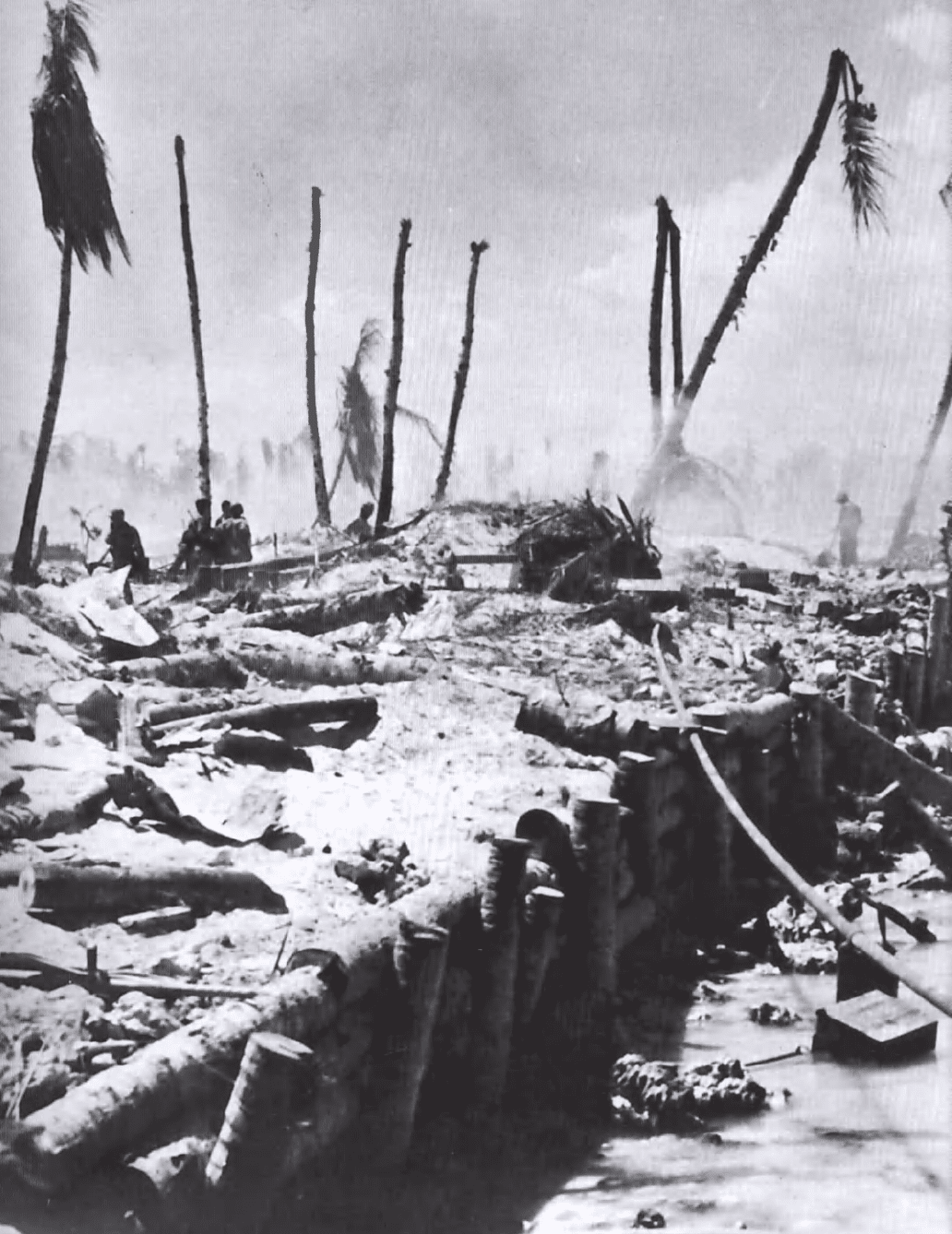
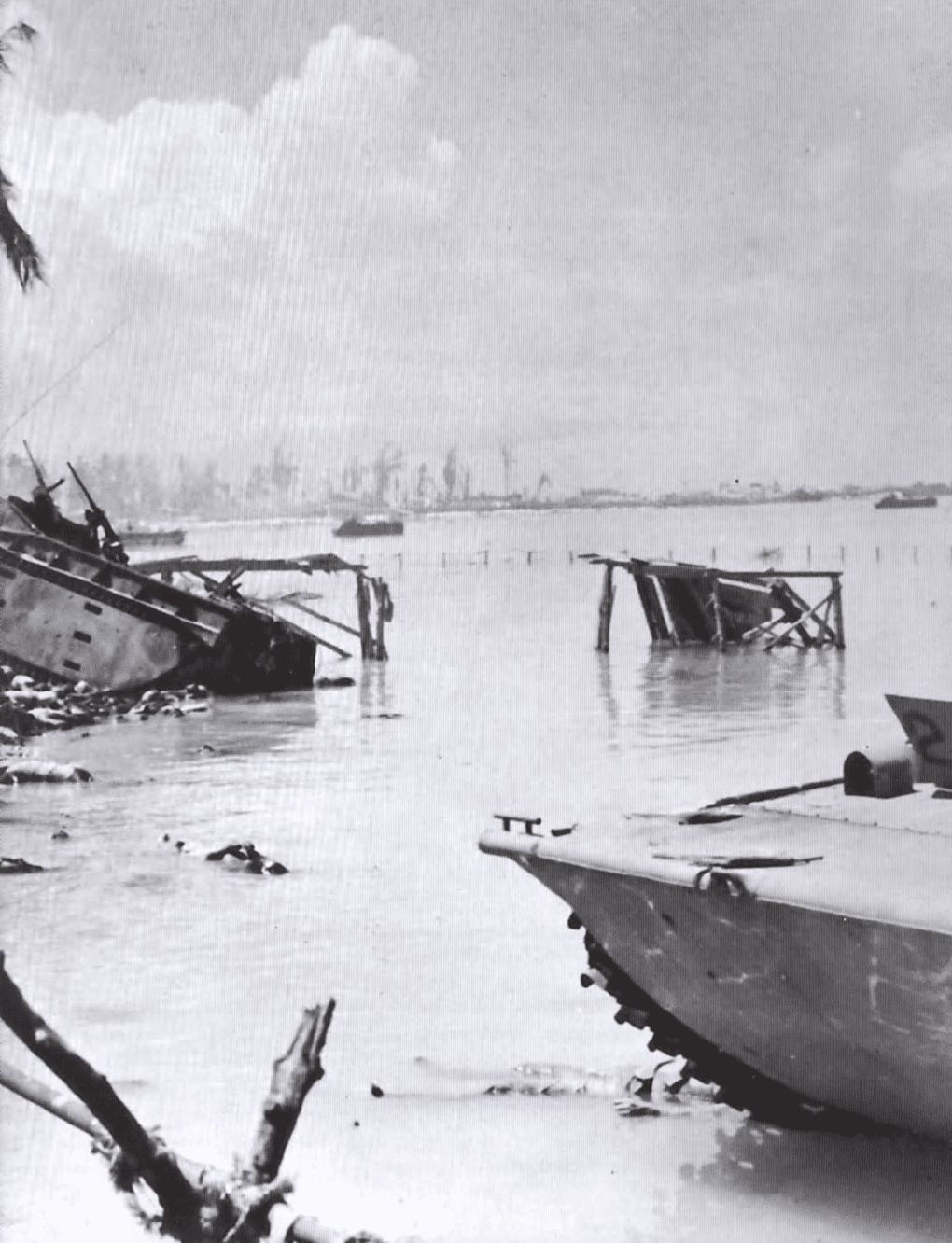
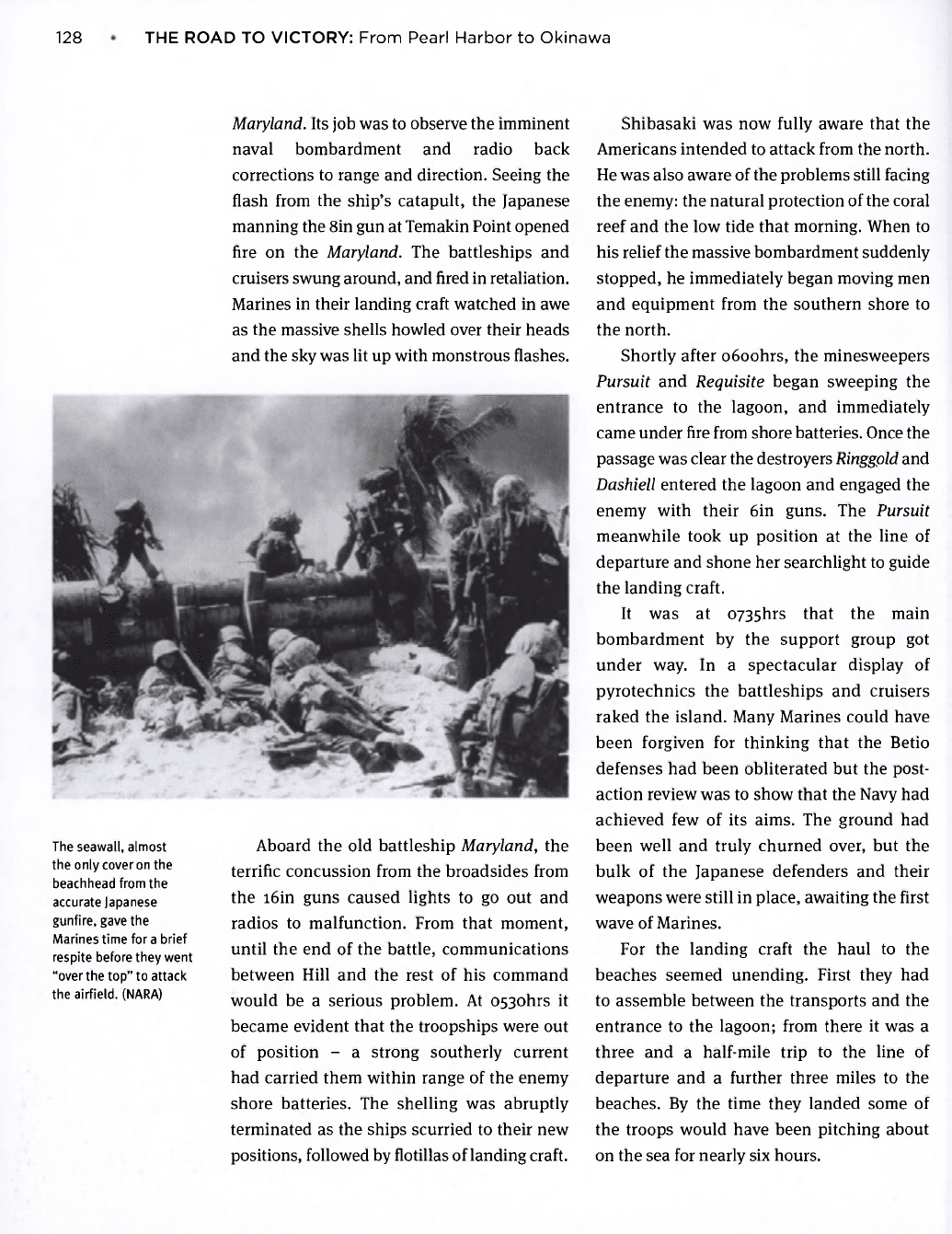
128 •
THE ROAD TO VICTORY: From Pearl Harbor to Okinawa
Maryland. Its job was to observe the imminent
naval bombardment and radio back
corrections to range and direction. Seeing the
flash from the ship's catapult, the Japanese
manning the 8in gun at Temakin Point opened
fire on the Maryland. The battleships and
cruisers swung around, and fired in retaliation.
Marines in their landing craft watched in awe
as the massive shells howled over their heads
and the sky was lit up with monstrous flashes.
The seawall, almost
the only cover on the
beachhead from the
accurate Japanese
gunfire, gave the
Marines time for a brief
respite before they went
"over the top" to attack
the airfield. (NARA)
Aboard the old battleship Maryland, the
terrific concussion from the broadsides from
the i6in guns caused lights to go out and
radios to malfunction. From that moment,
until the end of the battle, communications
between Hill and the rest of his command
would be a serious problem. At 0530hrs it
became evident that the troopships were out
of position - a strong southerly current
had carried them within range of the enemy
shore batteries. The shelling was abruptly
terminated as the ships scurried to their new
positions, followed by flotillas of landing craft.
Shibasaki was now fully aware that the
Americans intended to attack from the north.
He was also aware of the problems still facing
the enemy: the natural protection of the coral
reef and the low tide that morning. When to
his relief the massive bombardment suddenly
stopped, he immediately began moving men
and equipment from the southern shore to
the north.
Shortly after o6oohrs, the minesweepers
Pursuit and Requisite began sweeping the
entrance to the lagoon, and immediately
came under fire from shore batteries. Once the
passage was clear the destroyers Ringgold and
Dashiell entered the lagoon and engaged the
enemy with their 6in guns. The Pursuit
meanwhile took up position at the line of
departure and shone her searchlight to guide
the landing craft.
It was at 0735hrs that the main
bombardment by the support group got
under way. In a spectacular display of
pyrotechnics the battleships and cruisers
raked the island. Many Marines could have
been forgiven for thinking that the Betio
defenses had been obliterated but the post-
action review was to show that the Navy had
achieved few of its aims. The ground had
been well and truly churned over, but the
bulk of the Japanese defenders and their
weapons were still in place, awaiting the first
wave of Marines.
For the landing craft the haul to the
beaches seemed unending. First they had
to assemble between the transports and the
entrance to the lagoon; from there it was a
three and a half-mile trip to the line of
departure and a further three miles to the
beaches. By the time they landed some of
the troops would have been pitching about
on the sea for nearly six hours.
